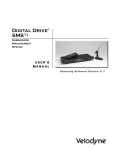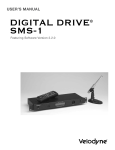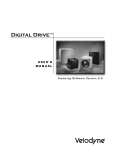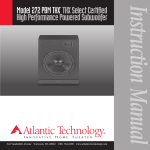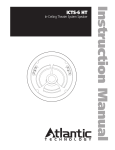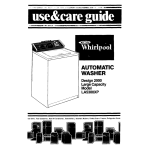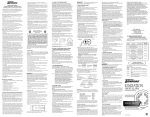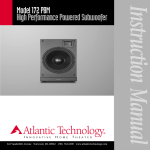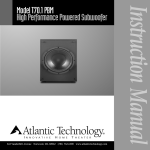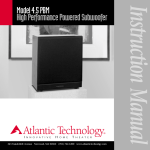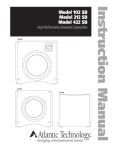Download Atlantic Technology SA-700 Instruction manual
Transcript
For use with Atlantic Technology IWTS-8 SUB Woofer Module Only LOCATION EQ LEVEL TRIM 75 PHASE 1.0 LOW PASS 90 180 -10 0 BASS LEVEL 80 270 Subwoofer 1 25 EQ 1 2 3 4 THX 125 0.2 1.5 -20 FREQUENCY WIDTH ATTENUATION 75 1.0 -10 MUTE 50 THX / EXT 0dB 90 180 0 150 MIN THX / REF MAX 150 MIN THX / REF MAX 80 270 I Subwoofer 2 ON/STDBY O 25 125 0.2 1.5 -20 0dB 50 THX / EXT SA-700 Servo Controlled Subwoofer Amplifier Atlantic Technology ® I N N O V A T I V E H O M E T H E A T E R SA-700 pictured This manual covers installation and operation of SA-350 Mono and SA-700 Dual Mono Subwoofer Amplifiers. Installation of the 8 SUB Woofer Module is covered separately by an instruction sheet included with the woofer. Atlantic Technology ® IN N O V A T I V E H O M E T H E A T E R Instruction Manual InWall Subwoofer System SA-350 Mono Subwoofer Amplifier SA-700 Dual Mono Subwoofer Amplifier 2 Safety Precautions InWall Subwoofer System IMPORTANT NOTE These instructions are for Atlantic Technology InWall Subwoofer systems using the SA-350 Mono and SA-700 Dual Mono Subwoofer amplifiers. All instructions and information pertain to both systems. Note that the SA-350 amplifier only has one set of front mounted controls and one set of input/output connectors on the back and is designed to work with a single 8 SUB woofer module. The unique design of these drivers and amplifiers means that they must only be used together, with each other. You should never attempt to use a different amplifier with these woofers or different woofers with these amplifiers. Features 8 SUB Woofer ■ Ultra-long-throw 8" Coated Composite Molded Graphite polymer cone drivers with vented 8 pound motor structure and 1-3/4" high temperature, 4 layer voice coil A massive magnetic motor assembly and high temperature parts combined with a bumped out rear plate and compliant suspension allow very long travel capability for the cone. The result is amazing bass performance from a relatively small footprint. One of the most powerful 8" subwoofer drivers ever designed, the motor assembly is much more consistent with 15" woofers! ■ Sealed enclosure design provides for low distortion deep bass output This design is inherently low in distortion and naturally delivers deep, smooth bass response with a gradual and predictable rolloff below resonance, ensuring accurate musical bass reproduction along with terrific special effects. Safety Precautions SA-350 and SA-700 ■ CAUTION: To reduce the risk of electric shock, do not remove the cover (or back). No user serviceable parts inside. Refer to qualified personnel. The fully discrete design utilizes audiophile grade component parts including an independent power supply for each channel with its own custom-wound, low-hum Toroidal transformer. Class G design means each of the power supplies is dual mode in operation, one for long term operation and the second for short term very high power peaks. High peak current delivers exceptional driver control. WARNING: To reduce the risk of fire or electric shock, do not expose this appliance to rain or moisture. The lightning flash with arrowhead, within an equilateral triangle, is intended to alert the user to the presence of uninsulated “dangerous voltage” within the product’s enclosure that may be of sufficient magnitude to constitute a risk of electrical shock to persons. The exclamation point within an equilateral triangle is intended to alert the user to the presence of important operating maintenance (servicing) instructions in the literature accompanying the appliance. For Future Reference ■ Servo-control circuitry This circuit monitors woofer performance. If the servo-control detects driver distortion it immediately regains control and eliminates it, resulting in very high output levels at unusually low distortion levels. ■ Built-in Parametric Equalizer (pages 5 and 13) Designed to flatten and smooth bass response deviations caused by standing waves at the listening position in your room. ■ Record your speaker and amplifier serial numbers and date of purchase here: Four Built-in Program Equalization and one Reference setting (pages 7 and 14) We’ve carefully chosen and built in several preset bass EQ curves, plus a flat/THX response setting, to enhance your enjoyment of all program materials . Model Number ■ Serial Number Wireless Remote Operation (pages 7 and 14) Control program EQs, volume trim adjustment, and full subwoofer muting from your listening position. Date of Purchase The serial number is found on the back of the speaker near the connecting terminals. Linear power high current discrete Class G amplifier conservatively rated at 350 watts RMS per channel with short term peak output ability in excess of 550 watts ■ A useful in room working frequency range of 20 Hz to 150Hz Introduction 3 Instruction Manual ■ ■ Adjustable (50 Hz to 150 Hz) low-pass crossover (@ 24 dB per octave) with a THX/External setting (pages 5, 12 and 14) Table of Contents Allows for much better bass integration with the satellite speakers while making the woofer less localizable. 4 InWall Subwoofer Systems Low level inputs, low level thruputs (pages 6 and 7) Thruputs allow daisy chaining of multiple subwoofers, or can act as a return path back to the processor. ■ Four position Phase Invert switch (pages 5, 12 and 14) Allows precise acoustic matching with satellite speaker systems whose output may be phase reversed. May also help to compensate for unusual room acoustics that can occur, causing a lack of or too much bass at the listening position. 5 6 7 7 7 7 7 8 9 ■ A convenient front panel mounted Level Control with a clickstop THX/REF input sensitivity setting (pages 5 and 14) 10 ■ Automatic standby operation with LED indicator (page 12) 11 12 Features signal sensing turn-on with 7-10 minute turn-off delay. ■ ■ Heavy-Duty detachable AC power cord and input socket (pages 6 and 12) Meets all current UL/CSA and European safety requirements THX Ultra Certified (SA-700 only) THX is a group of performance standards and technologies developed by Lucasfilm Ltd. (of Star Wars fame). These are intended to ensure that what you hear (and see) on your home system, as closely as possible, matches what the director heard and saw during the final production mixdown of the film. THX is intended to enhance all surround formats including the latest discrete multi-channel digital types. Please note that THX is not a surround format itself. THX Ultra standards are based upon a room size of 3000 cubic feet (LxWxH). This doesn’t mean certified components must be used in rooms this exact size. The room sizes simply provide a frame of reference, as they indicate that these systems must deliver a minimum level of performance in the specified area. 12 12 12 12 13 13 13 14 14 14 14 14 15 15 15 16 Amplifier Front Panel Amplifier Back Panel Remote Control Connecting Your Subwoofer Low Level Connection (LO IN) Using the Low Level Thruput (THRU) High Level Connection (HI IN) SA-350 Low Level Connections SA-700 Low Level Connections with one SubOut/LFE Output SA-700 Low Level Connections with two SubOut/LFE Outputs SA-700 High Level Connections Power Connection System Setup and Operation The LOW PASS Control Bass Management The PHASE Control Parametric Room Equalizer (EQ) Adjusting the Parametric EQ Using a Meter or Real Time Analyzer (RTA) Level Setting Using an SPL Meter Level Setting Setup Without Using an SPL Meter Setting the Subwoofer Level Without an SPL Meter or Test Tones How Much is Enough? Remote Control Functions Direct Access Connector Care and Feeding of Your Subwoofer Subwoofer Troubleshooting Guide Specifications Program EQ Setting Curves Test and Training CD-ROM The enclosed Atlantic Technology/Sencore Test and Training Disc includes lots of useful information. (Sencore is a world famous manufacturer of electronic test and measurement equipment. We strongly support the use of this caliber of equipment in the setup of home surround sound systems.) Please take a moment to go over its contents before proceeding with your woofer’s setup. The disc includes room mode calculators, explanations of how sound spreads in a room, information about home theater setup, a glossary, and even an explanation of how standing waves “setup” in rooms. Most importantly, there are test tones on the disc intended to be used to set the equalizer and subwoofer level in your system. Copyright © 2001 Atlantic Technology International. Specifications are those in effect at the time of printing. Atlantic Technology reserves the right to change specifications or designs at any time without notice. THX and THX Ultra are registered trademarks of Lucasfilm, Ltd. Dolby Digital, AC-3, Dolby Stereo and Dolby Pro Logic are trademarks of Dolby Laboratories Licensing Corporation. 4 InWall Subwoofer Systems InWall Subwoofer System InWall Subwoofer Systems Congratulations on your purchase of an Atlantic Technology InWall Subwoofer System. This unique “invisible subwoofer” will enhance your listening pleasure dramatically, by providing the bass foundation upon which most music and special effects are built. In addition, its flexible control capability brings new meaning to the terms system and room integration, providing unheard of fine tuning capability to optimize its performance and your enjoyment. The system consists of in-wall enclosures (Fig. 1) designed to be installed in your walls before the sheetrock is put up, a dual 8 inch woofer driver assembly (Fig. 2) and a separate dedicated amplifier and remote control (Fig. 3-4) to power the woofers. There are two versions of the system, a single sub assembly paired with an SA-350 mono amplifier and two subwoofer assemblies paired with the SA700 dual mono amplifier. The combination two subwoofer assembly/SA-700 system is THX Ultra certified. The InWall Subwoofer System is capable of delivering very high output levels and wide dynamic range. When properly set up and adjusted it will provide smooth in-room bass response down to approximately 25 Hz, with a peak SPL capability in excess of 105dB (using two dual woofer modules and the SA-700 amplifier, in a 3000 cubic foot space). Figure 1 Your Atlantic Technology powered subwoofer is designed to smoothly integrate with virtually all other brands of loudspeakers on the market. And from its premium gold plated connectors to its very flexible range of adjustment, this is one of the most versatile and unique high performance subwoofers ever produced. Figure 2 Figure 3 Atlantic Technology ® EQ1 EQ2 EQ4 EQ3 REF TRIM MUTE Figure 4 LOCATION EQ LEVEL TRIM 75 PHASE 1.0 LOW PASS 90 180 -10 0 BASS LEVEL 80 270 Subwoofer 1 25 EQ 1 2 3 4 THX 125 0.2 1.5 -20 WIDTH ATTENUATION 75 1.0 -10 MUTE 50 THX / EXT 0dB FREQUENCY 90 180 0 150 MIN THX / REF MAX 150 MIN THX / REF MAX 80 270 I Subwoofer 2 ON/STDBY O 25 Atlantic Technology ® IN N O V A T I V E H O M E T H E A T E R 125 0.2 1.5 -20 0dB 50 THX / EXT SA-700 Servo Controlled Subwoofer Amplifier Amplifier Front Panel 5 Instruction Manual Amplifier Front Panel Figure 5 1 2 3 4 LOCATION EQ LEVEL TRIM 75 PHASE 1.0 LOW PASS 90 180 -10 0 BASS LEVEL 80 270 Subwoofer 1 25 EQ 1 2 3 4 THX 125 0.2 1.5 -20 FREQUENCY WIDTH ATTENUATION 75 1.0 -10 MUTE 50 THX / EXT 0dB 90 180 0 150 MIN THX / REF MAX 150 MIN THX / REF MAX 80 270 I Subwoofer 2 ON/STDBY O 25 125 0.2 1.5 -20 50 THX / EXT 0dB SA-700 Servo Controlled Subwoofer Amplifier Atlantic Technology ® I N N O V A T I V E H O M E T H E A T E R 5 6 7 8 9 10 11 NOTE: Items in gray area are found on SA-700 amplifier only 1 LEVEL TRIM display window 7 Indicates level of trim adjustment applied above or below the reference volume setting of your subwoofer. (page 14) 2 3 Lights green when the unit is active and yellow when amplifier is in standby mode. Turns red to indicate that amplifier has entered protection mode. (page 12) FREQUENCY EQ control Selects the frequency to be adjusted by the parametric equalizer. (page 13) 8 WIDTH EQ control 9 ATTENUATION EQ control 10 Main Power switch Turns amplifier on or off. (page 12) LOW PASS crossover control Sets the low frequency crossover between the subwoofer and your satellite speakers. A detent setting is provided for THX/ EXT operation. (pages 12 and 14) Program Equalization indicators Light indicates selected Reference or EQ program. (page 14) 6 PHASE control Sets correct subwoofer phase (0°, 90°, 180°, or 270°) to best match your satellite speakers and room. (pages 12 and 14) Reduces the selected frequencies by the parametric equalizer. (page 13) 5 MUTE indicator Lights when amplifier volume is muted. (page 7) Selects how wide a range of frequencies will be adjusted by the parametric equalizer. (page 13) 4 ON/STDBY indicator 11 BASS LEVEL control Sets the reference volume level of the connected subwoofer(s). A detent setting is provided for THX/REF operation. (pages 13 and 14) 6 Amplifier Back Panel InWall Subwoofer System Amplifier Back Panel Figure 6 1 2 Atlantic Technology H O M E T H E A T E R VOL+ VOL– MUTE EQ1 EQ2 EQ3 EQ4 EQ5 COM N N O V A T I V E 4 5 COMMAND ® I MODEL - SERIAL NUMBER 3 6 SUBWOOFER 1 THRU – IR IN THRU LO IN – LO IN THRU HI IN + – SPEAKER OUTPUT + AC INPUT 120 VAC 50 / 60 Hz 1300W max ATTENTION: use specified speakers only DESIGNED AND ENGINEERED IN USA, MANUFACTURED IN TAIWAN + SPEAKER – OUTPUT + HI IN WARNING RISK OF ELECTRIC SHOCK DO NOT OPEN SUBWOOFER 2 AVIS: RISQUE DE CHOC ELECTRIQUE / NE PAS OUVRIR 7 8 9 10 NOTE: Items in gray area are found on SA-700 amplifier only 1 2 Product Serial Number 5 High Level Inputs Write this number in the space provided on page 2 for future reference. 8 Use the HI IN binding posts to connect a high level (speaker) output from your processor/amplifier. (page 7) Direct Access Remote Control port and IR port connector (included, not shown) 6 Subwoofer Outputs 7 Use the SPEAKER OUTPUT binding posts to connect the amplifier to the 8 SUB Module(s). (page 7) 10 AC Input Use for hard-wired direct access of remote control functions. 3 Remote Control jacks Use the IR IN jack to connect a remote sensor to the amplifier when line of sight with the remote control is not possible. Use the THRU jack to connect other devices to the sensor. (page 8) 4 9 Low Level jacks Use the LO IN jack to connect to the subwoofer line out from your processor/receiver. Use the THRU jack to pass the signal to the other channel of the SA-700 or to another device. (page 7) Use the included power cord to connect your amplifier to a wall outlet. (page 12) Connecting Your Subwoofer 7 Instruction Manual Remote Control Connecting Your Subwoofer The Atlantic Technology InWall Subwoofer System is simple to hook up, offering several connection methods for maximum flexibility. Study the system diagrams starting on Page 8. Once you have found the example which most closely matches your system, hook up your subwoofer(s) as shown in that diagram. In all cases, the 8 SUB Module(s) connect to the amplifier using the SPEAKER OUTPUT(s), with high-quality speaker wire, as outlined in the High Level Connection section below. Figure 7 Atlantic Technology ® EQ1 1 EQ2 EQ4 EQ3 REF 2 TRIM 4 MUTE 3 WARNING: To prevent risk of electrical shock or damage to your equipment, always unplug all component AC cords before proceeding with speaker and component connections! The last step in wiring your system should be plugging in the AC cords! Low Level Connection (LO IN) We suggest using the low level (RCA jack) subwoofer line out or preamp output if your receiver/processor has one. This jack may be labeled Sub, Subwoofer, or LFE (Low Frequency Effects). Simply connect to the LO IN jack(s) on your SA-350 or SA-700 amplifier with high-quality shielded cables as shown in Figures 8-10. Please consult your processor/receiver manual for further information. Using the Low Level Thruput (THRU) If your processor has a single subwoofer output and you are using the SA-700 Dual Mono amplifier connect it using the example in Figure 9 to connect both channels of the amplifier. We have supplied a short jumper to facilitate this connection method. The THRU jack(s) can also be used to run a low level signal through the amplifier and out to another unit, as shown in Figure 8. The signal that comes out of the THRU jack(s) is identical to the input signal. High Level Connection (HI IN) 1 Preset Program EQ buttons Select from 4 preset equalization settings. (page 14) 2 Reference EQ button REF button returns the amplifier to its flat/THX EQ settings and returns the volume trim level to 0dB. (page 14) 3 MUTE button Mutes the volume of the amplifier. Pressing again returns the amplifier to the previous volume setting 4 Level TRIM buttons The ▲ button increases and the ▼ button decreases the volume of the subwoofer above or below the preset reference level in 1dB increments. (page 14) Alternately, if you are using the SA-700 with dual 8 SUB Modules, you may use the high level (HI IN) inputs by following the diagram in Figure 11. If you do, we recommend that you use high-quality speaker wire of at least 16 gauge or larger. Please consult your audio/video specialist for more specific information. IMPORTANT NOTE: You can use the HI IN input on the SA-350 to connect one high level input from a single channel source. For stereo (2 channel) hookup, please contact Atlantic Technology for further information. You can connect to the HI IN inputs by using a variety of connectors, or by removing 1/2" of insulation from each wire end, twisting the individual strands of each conductor together, placing the wire through one of the post holes and screwing down the nut tightly. It’s important to observe polarity while making speaker connections: red (+) terminals on the amplifier to red (+) on the speaker, black (–) on the amplifier to black (–) on the speaker. Note that one wire in each pair will be marked by either the conductor color, printing on the wire jacket, a ridge on one side of the wire jacket, or a thread intertwined with the wire strands. By convention, the marked wire is connected to the red (+) terminal. 8 Connecting Your Subwoofer InWall Subwoofer System SA-350 Low Level Connections Figure 8 Sub Out/LFE Atlantic Technology COMMAND N O V A T I V E H O M E T H E A T E R VOL+ VOL– MUTE EQ1 EQ2 EQ3 EQ4 EQ5 COM ® IN MODEL - SERIAL NUMBER SUBWOOFER 1 THRU IR IN THRU LO IN – HI IN + – SPEAKER OUTPUT – ATTENTION: use specified speakers only DESIGNED AND ENGINEERED IN USA, MANUFACTURED IN TAIWAN + SPEAKER – OUTPUT + HI IN – LO IN THRU WARNING RISK OF ELECTRIC SHOCK DO NOT OPEN AVIS: RISQUE DE CHOC ELECTRIQUE / NE PAS OUVRIR – additional subwoofer amplifier additional audio/video devices Direct Access Remote Control + AC INPUT 120 VAC 50 / 60 Hz 1300W max + + Connecting Your Subwoofer Instruction Manual SA-700 Low Level Connections with one SubOut/LFE Output Figure 9 Sub Out/LFE Must connect jumper (supplied) Atlantic Technology COMMAND N N O V A T I V E H O M E T VOL+ VOL– MUTE EQ1 EQ2 EQ3 EQ4 EQ5 COM ® I H E A T E R MODEL - SERIAL NUMBER SUBWOOFER 1 THRU IR IN THRU LO IN – HI IN + – SPEAKER OUTPUT – ATTENTION: use specified speakers only + DESIGNED AND ENGINEERED IN USA, MANUFACTURED IN TAIWAN + + SPEAKER – OUTPUT – + HI IN – LO IN THRU WARNING RISK OF ELECTRIC SHOCK DO NOT OPEN SUBWOOFER 2 AVIS: RISQUE DE CHOC ELECTRIQUE / NE PAS OUVRIR + – – AC INPUT 120 VAC 50 / 60 Hz 1300W max + + 9 10 Connecting Your Subwoofer InWall Subwoofer System SA-700 Low Level Connections with two SubOut/LFE Outputs Figure 10 Sub Out/LFE Atlantic Technology COMMAND N N O V A T I V E H O M E T VOL+ VOL– MUTE EQ1 EQ2 EQ3 EQ4 EQ5 COM ® I Sub Out/LFE H E A T E R MODEL - SERIAL NUMBER SUBWOOFER 1 THRU IR IN THRU LO IN – HI IN + – SPEAKER OUTPUT – ATTENTION: use specified speakers only + DESIGNED AND ENGINEERED IN USA, MANUFACTURED IN TAIWAN + + SPEAKER – OUTPUT – + HI IN – LO IN THRU WARNING RISK OF ELECTRIC SHOCK DO NOT OPEN SUBWOOFER 2 AVIS: RISQUE DE CHOC ELECTRIQUE / NE PAS OUVRIR + – – AC INPUT 120 VAC 50 / 60 Hz 1300W max + + Connecting Your Subwoofer Instruction Manual SA-700 High Level Connections Figure 11 + – Atlantic Technology COMMAND N N O V A T I V E H O M E T VOL+ VOL– MUTE EQ1 EQ2 EQ3 EQ4 EQ5 COM ® I + – H E A T E R MODEL - SERIAL NUMBER THRU IR IN LO IN – SUBWOOFER 1 – HI IN + + – SPEAKER OUTPUT + DESIGNED AND ENGINEERED IN USA, MANUFACTURED IN TAIWAN + + SPEAKER – OUTPUT – + HI IN – LO IN THRU WARNING RISK OF ELECTRIC SHOCK DO NOT OPEN SUBWOOFER 2 AVIS: RISQUE DE CHOC ELECTRIQUE / NE PAS OUVRIR + – – AC INPUT 120 VAC 50 / 60 Hz 1300W max + – – + ATTENTION: use specified speakers only THRU + 11 12 System Setup and Operation InWall Subwoofer System Power Connection Connect the power cord to an AC outlet only after making all other connections to the subwoofer. This will avoid any chance of accidentally activating the subwoofer while wiring. DO NOT PLUG THE SA-350 OR SA-700 INTO THE SWITCHED OUTLET OF AN AMPLIFIER, PREAMPLIFIER, OR RECEIVER. The power demands of these amplifiers is substantial and will exceed the power rating of the switched outlet and may damage the equipment. Be sure that the printed voltage rating on the back of the amplifier is correct for your location. The InWall Subwoofer System is totally automatic in its operation. Once the main power switch on the front of the amplifier has been turned on, the automatic on/off circuitry will activate the subwoofer in the presence of an audio signal from your system. After 7-10 minutes with no signal detected from the rest of the system, the amplifier will return to the Standby mode. When the sub is in operating mode, the power LED located on the front of the amplifier will glow green. The LED will switch to yellow in the Standby mode and power consumption in this mode is negligible. When you leave for a longer period of time, (vacation, weekend away, etc.) we recommend shutting off the main power switch on the front panel of the amplifier. System Setup and Operation Since this is an in-wall system we assume that you already have the woofer modules installed in your room as per the guidelines provided with the InWall Enclosure. Generally speaking, the closer the subwoofer is placed to a corner, the more and deeper the bass response you will hear. However, in some rooms, corner placement can produce too much bass or a “one note” boomy effect. Should you find this to be the case in your room after installation, the built in parametric EQ can be used to improve the situation. The LOW PASS Control When used with a complete THX Certified speaker system, the InWall Subwoofer System LOW PASS control should be set at 80Hz unless you are using a processor with its own built-in crossover. If your processor is THX certified or has a built-in crossover, set the subwoofer amplifier’s LOW PASS control to the THX/EXT setting. All THX certified satellites has been optimized to work LOW PASS with an 80 Hz crossover point. If your Processor/Receiver has no internal crossover (a fairly rare occurrence these days) the subwoofer’s crossover should be 50 150 used to optimize the performance of the THX / EXT system, by ensuring that the subwoofer and satellites produce a cohesive and well integrated sound “picture.” 80 Higher crossover frequencies pass more bass but can quickly begin to sound boomy. They also make it easier to localize the subwoofer, which is highly undesirable. Higher crossover frequencies may be suitable, however, when using very small satellites that have no real low frequency performance. Settings lower than 80Hz should be employed if you are using larger speakers that have extended bass response. This way, the subwoofer will only reproduce the very lowest bass frequencies that are in the range where the large main speakers begin to roll off. It’s generally undesirable to have the main speakers and the subwoofer overlap too much. Larger speakers means a lower LOW PASS crossover frequency, smaller speakers means a higher LOW PASS crossover frequency. Consult the manufacturer’s specified low frequency response for your main speakers to determine the appropriate LOW PASS setting on your subwoofer. In the end, however, a little time spent experimenting will generally result in dramatically better bass response. A Word About Bass, Center Channel Modes, and System Setup Many Dolby Pro Logic surround processors and surround receivers provide a choice between “Wide” (full frequency range) and “Normal” (restricted low frequency) mode for the center channel speaker. Atlantic Technology recommends that the center channel be operated in the Normal mode when using a powered subwoofer. The center channel speaker will sound more dynamic and the intelligibility of the system will generally be improved when in the Normal mode. Bass Management Many newer processor/receivers offer Bass Management capability. If yours does it will ask you to choose between Large and Small loudspeakers during the system setup procedure. When speakers are set to Large the processor/receiver assumes that they can produce full frequency range sound, including very deep bass at fairly high volume levels. When set to small it assumes that the speakers are bass limited and feeds the bass from that channel to the subwoofer. If your processor/receiver offers this choice, all Atlantic Technology satellite speakers should be set to Small. For those of you who may have heard otherwise, the choice of Large or Small is not a matter of opinion, preference, taste, or based upon the phases of the moon. So please ignore all the free and helpful (and many times incorrect) advice and set’em to Small. In fact, the vast majority of speakers on the market today should be set to small. As a rule of thumb, if any satellite speaker in your system doesn’t have a 10 inch diameter or larger woofer it most probably should be set to small, as far as Bass Management is concerned. The PHASE Control A subwoofer operating out of phase with the rest of the system won’t provide optimum low frequency performance. Also, the correct subwoofer phase can enhance room acoustics. Since there is some variation in the industry regarding phase, a PHASE switch that will alter the phase of the subwoofer is provided on PHASE the amplifier. It has 4 positions (0°, 90°,180°,270°) for added flexibility. To set the PHASE control, 90 180 insert the supplied Atlantic Technology/Sencore 0 270 Test and Training CD in your CD/DVD player and select the broadband bass test tones on Tracks 22. Have someone sit in the prime listen- Operation 13 Instruction Manual ing position to evaluate the sound. Pay particular attention to the deep bass as well as the transition of bass from the subwoofer to the satellite speakers. You can also listen to a musical source such as a CD or DVD, with strong bass content that spans the range from deep bass to mid bass (a well recorded jazz disc with someone playing a full stand up bass is always a good choice). It’s usually best not to use a “one note” special effects track like a big explosion or dinosaur stomping to test the subwoofer. Experiment with the position of the PHASE control(s) to get the most extended bass and the best transition from sub to satellites. It should be obvious which is the correct setting. In particular, there will be a smoother more integrated transition between the satellites and the subwoofer when they are properly phased. Parametric Room Equalizer (EQ) In order to optimize the performance of your InWall subwoofer the Parametric Equalizer should be utilized. The built in Parametric EQ(s) allow you to select the frequency you want to adjust, and how wide a band on either side of that frequency you’re going to adjust with it. They are designed specifically to remove (turn down) unwanted peaks in the bass. The procedure is fairly simple: the included Atlantic Technology/Sencore Test and Training CD is used along with a meter to define the single largest bass peak at the prime listening position and then reduce it with the Parametric EQ. The test and setup CD also includes a wealth of general information concerning sound reproduction and home theater, in addition to the test tones. Although one set of tones is intended for setting the EQ “by ear” we very strongly recommend using a Sound Pressure Level (SPL) meter or a Real Time Analyzer to set the Parametric EQ. Adjusting the Parametric EQ Using a Meter or Real Time Analyzer (RTA) It’s important to complete all the preceding steps regarding speaker setup before setting the parametric equalizer. Once they are complete, insert the Atlantic Technology/Sencore Test and Training CD into your CD or DVD player and go to Track 22, which contains bass frequencies from 20Hz to 120Hz. Set the BASS LEVEL of a single subwoofer channel to 75dB at the primary listening position. If you are using an RTA, set it to at least 1/6th octave resolution and slow response. Continue using Track 22 and measure the response of the sub using at least a 1/6th octave resolution (Use slow response to allow the meter to average the standing waves that build up in the room). Chances are that you will find at least one significant peak in the subwoofer’s range (between 20Hz and the crossover point set on the sub or in the processor). Write down the center frequency of the peak, how “wide” the peak is (by noting the upper and lower frequencies where it starts and stops) and how high it is, in dB. Begin setting the Parametric EQ by adjusting the FREQUENCY control to the approximate center frequency of the peak. Next adjust the WIDTH control to the approximate width of the peak. Note that the WIDTH control is calibrated in octaves. An octave is a doubling or halving of any chosen frequency. For example, if the chosen fre- quency is 40Hz, 1 octave higher would be 80Hz, and one octave lower 75 1.0 -10 would be 20Hz. Since the WIDTH control ranges from 0.2 octave to 1.5 oc25 125 0.2 1.5 -20 0dB taves you see that you can FREQUENCY WIDTH ATTENUATION adjust a from a fairly narrow band to a fairly wide band on either side of the center frequency, depending upon how wide the peak is. Next, set the ATTENUATION control to the approximate –dB value to compensate for the peak. Measure the bass response again and see if you have significantly reduced the overall peak. You may need to fine tune any or all of the controls to smooth the response as much as possible. LOCATION EQ Level Setting Using an SPL Meter If you only have an SPL meter, set the meter to “C” weighting and “Slow” response then use Track 22 to set the BASS LEVEL to 75dB. Next use Tracks 1-21 sequentially to measure the subwoofer response. Take enough time with each measurement to allow the meter to stabilize. Write down the measured level for each frequency, covering the range from 20Hz to the crossover point selected on the subwoofer amplifier or in the receiver/processor. After you have defined the peak, proceed as outlined above to reduce it. When setting up a complete home theater we strongly recommend that you use a Sound Pressure Level meter. At the time of this writing Radio Shack® has one that is very affordably priced (approximately $40) and works well. However, for the best result in setting up the levels and the parametric EQ you would be much better served by using a true audio test instrument with a Real Time Acoustic Analyzer (RTA) like the Sencore® SP 295. To use an SPL meter, turn on your system, put the Processor/Receiver in the Test Mode and set its main volume control to a moderate volume level. If the volume control has a 0dB setting with minus dB below and plus dB above 0, set the control to 0dB. Next, sit in the prime listening position, set the SPL meter to the 70dB scale, Slow Response, and C Weighting. Now, holding the meter pointed up and in front of you, let the system cycle its test tone from speaker to speaker. Check the meter and set every speaker (including the subwoofer), to 75dB using the individual level settings in the Processor/Receiver. You may have to use the Processor/Receiver’s main volume control to get the left front speaker to 75 dB but from then on use the receiver’s internal level adjustments. These are almost always accessible through the Processor/Receiver’s remote control. As tempting as it may be to set the subwoofer and/or surround speakers higher than 75dB, set them to 75dB and see if you can acclimate to it. Try watching several different movies and keep in mind that the goal is to have a system that sounds like you’re actually “in the movie.” In most cases, you shouldn’t be consciously aware of the surround output at all. 14 Remote Control Functions InWall Subwoofer System When using the latest discrete digital electronics we recommend setting the subwoofer amplifier’s BASS LEVEL control to its THX/ REF position and using the Processor/Receiver’s built-in subwoofer level control. Should you have difficulty achieving the correct subwoofer volume this way or should your Processor/Receiver not have a subwoofer level adjustment built in, you can use the subwoofer amplifier’s main BASS LEVEL control to make this adjustment. Level Setting Without an SPL Meter If you decide not to use an SPL meter try to set all the speaker levels the same using the Test Tones. Of course, this will be much more difficult without the meter, especially for the subwoofer. Setting the Subwoofer Level Without an SPL Meter or Test Tones Start your listening with the subwoofer LOW PASS control set at the correct crossover point (or in the THX/EXT position if you’re using a THX Certified processor or unit with a built-in crossover). Set the PHASE control to 0°, and the front panel BASS LEVEL control to the THX/REF position as shown to the left. PHASE LOW PASS BASS LEVEL Play some music that you know has good bass content, and turn the Processor/ Receiver’s level control up until you just start to hear the subwoofer working. Now, from your normal listening position, determine whether the subwoofer is playing loudly enough and filling in the bass frequencies of the music evenly. If adjustment is necessary, change the processor’s setting or use the front panel BASS LEVEL control if your processor lacks a subwoofer level adjustment. 90 180 0 80 270 50 THX / EXT 150 MIN THX / REF MAX How Much is Enough? Sometimes people prefer more bass impact for movies than sounds natural when reproducing music. Since you have the 4 EQ settings plus the LEVEL TRIM, it’s now a snap to adjust the subwoofer to compensate for any variations in the source material. Remember however, the most common error people make when setting up their system is to play the subwoofer (and surrounds) too loudly. Should you desire the most accurate overall reproduction, a well balanced sound from deepest bass to highest treble is the best way to get it. Have fun. Experiment. Enjoy. Remote Control Functions There are 4 custom EQ settings that have been programmed into your subwoofer amplifier (see graphs on back cover). These have been chosen to enhance your enjoyment of both movies and music. These EQ settings are fairly subtle, as we wanted to make them truly useful with a wide selection of software. They are accessed by using the four EQ buttons on your Remote Control. EQ1 This EQ was designed to enhance music. It actually reduces the midbass of the subwoofer by a EQ4 REF small but noticeable amount. You will find that with most music this TRIM tends to make the bass sound tighter and more defined. It should make individual bass notes easier to hear as well. EQ1 can also be used to remove some “boominess” from the bass when playing particularly bass heavy material. EQ2 This EQ was programmed to enhance the impact and “punch” of special effects. It consists of an increase in the bass response centered around 60Hz. Depending upon the source material, EQ2 could also be used to fill in a bass shy music recording. EQ3 Another choice primarily intended to enhance movie and video soundtracks. This one uses a more subtle increase of bass output centered at 80HZ with the addition of a very low frequency filter. This gives you the option of punching up the mid-bass while at the same time reducing the possibility of overdriving the woofers with extreme low frequencies. EQ4 We call EQ4 “After Dark.” Our ears are less sensitive to the frequency extremes (deep bass and very high sounds) at lower volume levels. In order to compensate during those times when you must play the system at lower volume levels, EQ4 has been designed to raise the overall bass output of the sub slightly. The result will be a fuller and richer sounding bass at low volumes levels. EQ4 is designed to enhance both music and movies. It can also help if you have a low bass problem at the listening position. REF This resets the EQ to flat response and the volume trim to 0dB. LEVEL TRIM and MUTE The ▼ TRIM and ▲ buttons let you change the total output level of your subwoofer MUTE to compensate for soundtrack variations and your personal preferences. Each push of the button results in a 1dB change above or below the preset reference level set with the BASS LEVEL control. The LEVEL TRIM readout on the amplifier indicates the level of adjustment numerically. Pressing the MUTE button turns off the volume of the subwoofer. Pressing it again returns the volume to its previous setting. EQ1 EQ2 EQ3 Direct Access Connector Located on the rear panel, this port and the corresponding male plug (included and installed in the port) is for use with a hard wired remote control system using electronic or mechanical switching. Each contact function is labeled. To access the control functions use a normally open connection. Momentary closure will activate each function. The LEVEL TRIM function will respond in 1dB steps to a single contact closure while constant closure will result in continuous steps to the maximum of + or – 10dB. The REF EQ and REF volume reset functions each have their own set of contacts. Specifications 15 Instruction Manual Care and Feeding of Your Subwoofer IMPORTANT: Save Your Boxes! If you can do so, save the carton, packing pieces and plastic bags that came with your subwoofer. They will be useful in case you move or have to ship your subwoofer for any reason. In any case, save all packing materials until you are certain that the system has suffered no damage in shipment. If you find such damage, either visible or internal, contact your dealer immediately for the proper return procedure. Subwoofer Troubleshooting Guide Once your subwoofer is set up, you should have many years of maintenance free enjoyment from your system. However, if you should encounter a problem, refer to the following guide to help find the solution. If the problem persists, please contact your local authorized Atlantic Technology dealer. Problem Possible Cause Possible Solution No bass output AC power cord unplugged or plugged into a non-working outlet. Plug into a working outlet. Input cables not securely connected or defective. Check all connections, then try another input cable. Input cable not securely connected or defective. Check all connections, then try another input cable. Ground loop through antenna or cable TV system input. Test by disconnecting antenna and/or cable system input leads. If hum goes away, install isolation balun(s) at that point. Input source connected to HI LEVEL inputs is wired out of phase. Check speaker wire connections and reconnect in proper phase. Audible buzz or hum Weak bass: vague stereo image Specifications RMS Power (before limiting and servo) 350 Watts/Channel Dynamic IHF Peak Power 550 Watts/Channel Signal to Noise Ratio (-90dB hum) -97dB @ full power Total Harmonic Distortion 0.05% @ full output Frequency Response (typical, in room) 20-150 Hz ±3 dB Low Level Input Sensitivity 250mv @ full output, 100Hz Low Level Input Impedance 22K Ω High Level Input Sensitivity 2.5v @ full output, 100Hz High Level Input Impedance 820 Ω Power Supply Storage 27K microfarads/channel Toroidal Transformer(s) 400VA/Channel Peak Output Stage Current 40amps rated/Channel Dimensions W x H x D (inches) 19.0 (faceplate); 16.875 (enclosure) x 5.0 (feet and faceplate) x 14.0 Weight (lbs) SA-350 = 22.3; SA-700 = 38.9 Program EQ Setting Curves EQ1 Sound Pressure Level 95 95 90 90 85 85 80 75 75 70 65 65 50 100 Frequency (Hz) 500 100 60 10 1K EQ3 Sound Pressure Level 100 Frequency (Hz) 500 1K 95 90 90 85 85 80 75 500 1K 80 75 70 70 65 65 50 100 Frequency (Hz) Sound Pressure Level 100 95 60 10 50 EQ4 SPL (dB) SPL (dB) 80 70 60 10 Sound Pressure Level 100 SPL (dB) SPL (dB) 100 EQ2 500 1K 60 10 50 100 Frequency (Hz) REF/THX (flat) 100 Sound Pressure Level Note: These graphs represent the response of the amplifier withour crossovers. In actual use, the system is not designed to respond beyond 200Hz. 95 SPL (dB) 90 85 80 75 70 65 60 10 50 100 Frequency (Hz) 500 1K Atlantic Technology ® I N N O V A T I V E H O M E T H E A T E R 343 Vanderbilt Avenue Norwood, MA 02062 (781) 762-6300 www.atlantictechnology.com 010-1700
















